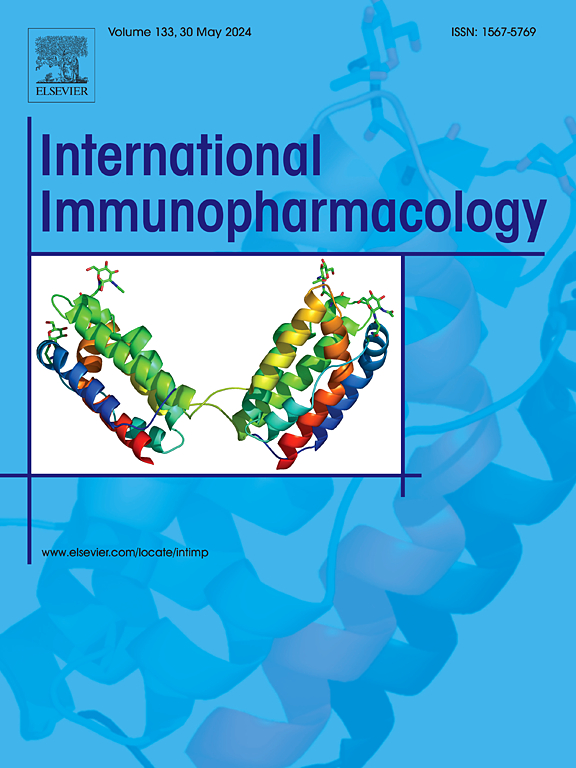ITGB4/GNB5轴促进M2巨噬细胞在NSCLC转移中的重编程
IF 4.8
2区 医学
Q2 IMMUNOLOGY
引用次数: 0
摘要
目的:非小细胞肺癌(NSCLC)的转移是导致高死亡率的主要原因之一。近年来,M2巨噬细胞在肿瘤微环境中促进肿瘤转移的作用日益受到关注。本研究旨在探讨ITGB4/GNB5轴在调控M2巨噬细胞重编程和影响NSCLC转移中的作用和潜在机制:本研究首先利用单细胞测序技术揭示了NSCLC肿瘤组织中多样化的亚群结构。然后通过数据分析确定了M2巨噬细胞与NSCLC恶性表型之间的相关性。流式细胞术和免疫组化被用来检测NSCLC组织中M2巨噬细胞的变化。通过RNA测序和蛋白质组分析评估了ITGB4/GNB5轴对M2巨噬细胞功能的影响。最后,通过体外细胞实验和体内小鼠模型验证了该轴的功能和调控机制:我们的研究发现,NSCLC 肿瘤组织中有多种细胞亚群,其中 M2 巨噬细胞与 NSCLC 的恶性表型密切相关。我们发现 ITGB4 是 NSCLC 的特征基因,并通过数据库分析预测 GNB5 是一个相互作用基因。研究表明,ITGB4/GNB5轴的激活会增强M2巨噬细胞的极化,促进它们在肿瘤微环境中的聚集。这种变化通过调节相关细胞因子和信号通路,进一步促进了 NSCLC 的侵袭和转移。动物实验表明,抑制 ITGB4/GNB5 轴可显著减少肿瘤的生长和转移:ITGB4/GNB5轴通过促进M2巨噬细胞极化和功能增强重塑了TME,从而促进了NSCLC的肿瘤侵袭和转移。这项研究为了解 NSCLC 的分子机制提供了新的视角,并为未来的靶向治疗提供了潜在的分子靶点。本文章由计算机程序翻译,如有差异,请以英文原文为准。
ITGB4/GNB5 axis promotes M2 macrophage reprogramming in NSCLC metastasis
Objective
Metastasis of non-small cell lung cancer (NSCLC) is a leading cause of high mortality. In recent years, the role of M2 macrophages in promoting tumor metastasis within the tumor microenvironment has garnered increasing attention. This study aims to investigate the role and potential mechanisms of the ITGB4/GNB5 axis in regulating M2 macrophage reprogramming and influencing NSCLC metastasis.
Methods
This study first used single-cell sequencing technology to reveal the diverse subpopulation structure of NSCLC tumor tissues. Data analysis then identified the correlation between M2 macrophages and the malignant phenotype of NSCLC. Flow cytometry and immunohistochemistry were used to detect changes in M2 macrophages in NSCLC tissues. The impact of the ITGB4/GNB5 axis on M2 macrophage function was assessed through RNA sequencing and proteomic analysis. Finally, in vitro cell experiments and in vivo mouse models were used to validate the function and regulatory mechanisms of this axis.
Results
Our study found diverse cellular subpopulations in NSCLC tumor tissues, with M2 macrophages closely associated with the malignant phenotype of NSCLC. We identified ITGB4 as a characteristic gene of NSCLC and predicted GNB5 as an interacting gene through database analysis. Activation of the ITGB4/GNB5 axis was shown to enhance M2 macrophage polarization, promoting their accumulation in the tumor microenvironment. This change further facilitated NSCLC invasion and metastasis by modulating related cytokines and signaling pathways. Animal experiments demonstrated that inhibition of the ITGB4/GNB5 axis significantly reduced tumor growth and metastasis.
Conclusion
The ITGB4/GNB5 axis reshapes the TME by promoting M2 macrophage polarization and functional enhancement, thereby facilitating tumor invasion and metastasis in NSCLC. This research provides new insights into the molecular mechanisms of NSCLC and offers potential molecular targets for future targeted therapies.
求助全文
通过发布文献求助,成功后即可免费获取论文全文。
去求助
来源期刊
CiteScore
8.40
自引率
3.60%
发文量
935
审稿时长
53 days
期刊介绍:
International Immunopharmacology is the primary vehicle for the publication of original research papers pertinent to the overlapping areas of immunology, pharmacology, cytokine biology, immunotherapy, immunopathology and immunotoxicology. Review articles that encompass these subjects are also welcome.
The subject material appropriate for submission includes:
• Clinical studies employing immunotherapy of any type including the use of: bacterial and chemical agents; thymic hormones, interferon, lymphokines, etc., in transplantation and diseases such as cancer, immunodeficiency, chronic infection and allergic, inflammatory or autoimmune disorders.
• Studies on the mechanisms of action of these agents for specific parameters of immune competence as well as the overall clinical state.
• Pre-clinical animal studies and in vitro studies on mechanisms of action with immunopotentiators, immunomodulators, immunoadjuvants and other pharmacological agents active on cells participating in immune or allergic responses.
• Pharmacological compounds, microbial products and toxicological agents that affect the lymphoid system, and their mechanisms of action.
• Agents that activate genes or modify transcription and translation within the immune response.
• Substances activated, generated, or released through immunologic or related pathways that are pharmacologically active.
• Production, function and regulation of cytokines and their receptors.
• Classical pharmacological studies on the effects of chemokines and bioactive factors released during immunological reactions.

 求助内容:
求助内容: 应助结果提醒方式:
应助结果提醒方式:


